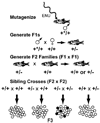Studying rod photoreceptor development in zebrafish
- PMID: 16199068
- PMCID: PMC2810101
- DOI: 10.1016/j.physbeh.2005.08.020
Studying rod photoreceptor development in zebrafish
Abstract
The zebrafish has rapidly become a favored model vertebrate organism, well suited for studies of developmental processes using large-scale genetic screens. In particular, zebrafish morphological and behavioral genetic screens have led to the identification of genes important for development of the retinal photoreceptors. This may help clarify the genetic mechanisms underlying human photoreceptor development and dysfunction in retinal diseases. In this review, we present the advantages of zebrafish as a vertebrate model organism, summarize retinal and photoreceptor cell development in zebrafish, with emphasis on the rod photoreceptors, and describe zebrafish visual behaviors that can be used for genetic screens. We then describe some of the photoreceptor cell mutants that have been isolated in morphological and behavioral screens and discuss the limitations of current screening methods for uncovering mutations that specifically affect rod function. Finally, we present some alternative strategies to target the rod developmental pathway in zebrafish.
Figures




Similar articles
-
Targeted disruption of the endogenous zebrafish rhodopsin locus as models of rapid rod photoreceptor degeneration.Mol Vis. 2018 Aug 27;24:587-602. eCollection 2018. Mol Vis. 2018. PMID: 30210230 Free PMC article.
-
Development of a rod photoreceptor mosaic revealed in transgenic zebrafish.Dev Biol. 2003 Jun 15;258(2):277-90. doi: 10.1016/s0012-1606(03)00125-8. Dev Biol. 2003. PMID: 12798288
-
Large-scale phenotypic drug screen identifies neuroprotectants in zebrafish and mouse models of retinitis pigmentosa.Elife. 2021 Jun 29;10:e57245. doi: 10.7554/eLife.57245. Elife. 2021. PMID: 34184634 Free PMC article.
-
Zebrafish Models of Photoreceptor Dysfunction and Degeneration.Biomolecules. 2021 Jan 9;11(1):78. doi: 10.3390/biom11010078. Biomolecules. 2021. PMID: 33435268 Free PMC article. Review.
-
Rod progenitor cells in the mature zebrafish retina.Adv Exp Med Biol. 2008;613:361-8. doi: 10.1007/978-0-387-74904-4_42. Adv Exp Med Biol. 2008. PMID: 18188965 Free PMC article. Review.
Cited by
-
Identification of nonvisual photomotor response cells in the vertebrate hindbrain.J Neurosci. 2013 Feb 27;33(9):3834-43. doi: 10.1523/JNEUROSCI.3689-12.2013. J Neurosci. 2013. PMID: 23447595 Free PMC article.
-
Color Processing in Zebrafish Retina.Front Cell Neurosci. 2018 Oct 3;12:327. doi: 10.3389/fncel.2018.00327. eCollection 2018. Front Cell Neurosci. 2018. PMID: 30337857 Free PMC article. Review.
-
Modeling Lysosomal Storage Diseases in the Zebrafish.Front Mol Biosci. 2020 May 6;7:82. doi: 10.3389/fmolb.2020.00082. eCollection 2020. Front Mol Biosci. 2020. PMID: 32435656 Free PMC article. Review.
-
Comparing Ocular Toxicity of Legacy and Alternative Per- and Polyfluoroalkyl Substances in Zebrafish Larvae.Toxics. 2023 Dec 14;11(12):1021. doi: 10.3390/toxics11121021. Toxics. 2023. PMID: 38133422 Free PMC article.
-
Genetic Dissection of Dual Roles for the Transcription Factor six7 in Photoreceptor Development and Patterning in Zebrafish.PLoS Genet. 2016 Apr 8;12(4):e1005968. doi: 10.1371/journal.pgen.1005968. eCollection 2016 Apr. PLoS Genet. 2016. PMID: 27058886 Free PMC article.
References
-
- Streisinger G, Walker C, Dower N, Knauber D, Singer F. Production of clones of homozygous diploid zebra fish (Brachydanio rerio) Nature. 1981;291(5813):293–296. - PubMed
-
- Driever W, Solnica-Krezel L, Schier AF, Neuhauss SC, Malicki J, Stemple DL, et al. A genetic screen for mutations affecting embryogenesis in zebrafish. Development. 1996;123:37–46. - PubMed
-
- Haffter P, Granato M, Brand M, Mullins MC, Hammerschmidt M, Kane DA, et al. The identification of genes with unique and essential functions in the development of the zebrafish, Danio rerio. Development. 1996;123:1–36. - PubMed
-
- Malicki J, Neuhauss SC, Schier AF, Solnica-Krezel L, Stemple DL, Stainier DY, et al. Mutations affecting development of the zebrafish retina. Development. 1996;123:263–273. - PubMed
Publication types
MeSH terms
Grants and funding
LinkOut - more resources
Full Text Sources

